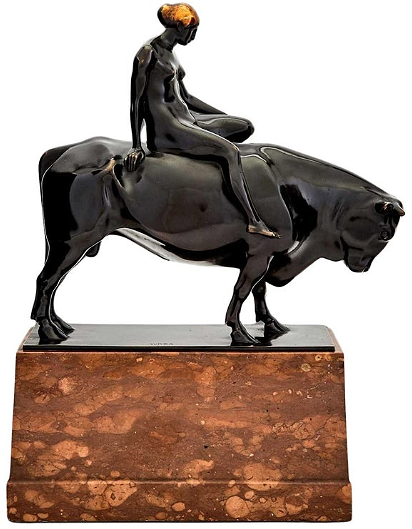SC-18
Bronze Sculpture, "Europa and the Bull" by Georg Wrba
Georg Wrba, German, 1872-1939 "Europa and the Bull", bronze with dark brown patina and gilt accents. Signed Wrba in the center of the plinth; with the foundry stamp C. Leyrer München on the side edge Germany: circa 1900 Shown at the 8th exhibition of the Viennese secession movement in 1900, exhibited on top of a cabinet designed by C. R. Ashbee. An other example is documented in the flat of Mr. Gustav Pollak, Vienna for which Josef Hoffmann was commissioned to design the interior in 1901. Ref.: Dekorative Kunst, vol. IV, p. 185 Provenance: Private New York Art Deco collection. Wrba was born in Munich in 1872, the son of a smith. His younger brother Max Wrba became an architect in Dresden. Wrba began his training with Jakob Bradl the Elder and his son Jakob Bradl the Younger. From 1891 to 1896, he studied at the Akademie der Bildenden Künste München under Syrius Eberle. After some time spent in Italy (with Egon Rheinberger), a trip made possible by a travel award from Prince Regent Luitpold, he settled in Munich as an independent sculptor in 1897 and became director of the city's school of sculpture. In 1906 and 1907, he worked in Berlin, where he created sculptures for buildings for the architects Ludwig Hoffmann and Alfred Messel. Wrba then moved to Dresden, where from 1907 to 1930 he taught at the Dresden Academy of Fine Arts. He brought the Dresden school of sculpture into contact with the reforming ideas of the Deutscher Werkbund and was a founding member of the Dresden Artists' Association, known as "Die Zunft" ("The Guild"). The basic aim of the "Werkbund", and also of "Die Zunft", was to achieve a collaboration between and integration of various forms of art, rejecting ornamentation for its own sake: painting and sculpture were to form integral parts of architecture. In Dresden he made, among many other works, the Marie Gey Fountain near the Dresden Hauptbahnhof in the Südvorstadt, which was donated by a Dr. Heinze for his wife, a student at the Kunstakademie, who had died young. In 1910 Wrba agreed a contract for the restoration and completion of the missing parts of the Zwinger, for which he directed the work of 53 sculptors from 1911 to 1933, and himself created many groups of figures modelled from the life. Wrba died on 9 January 1939 in Dresden, where a street is named after him. He is buried in the Munich Waldfriedhof.
- width
- 11.75 in.
- height
- 17.5
- depth
- 3.5 in.
- condition
- Good original patina and general condition faint scratches visible. Consistent with age
Circa 1900







